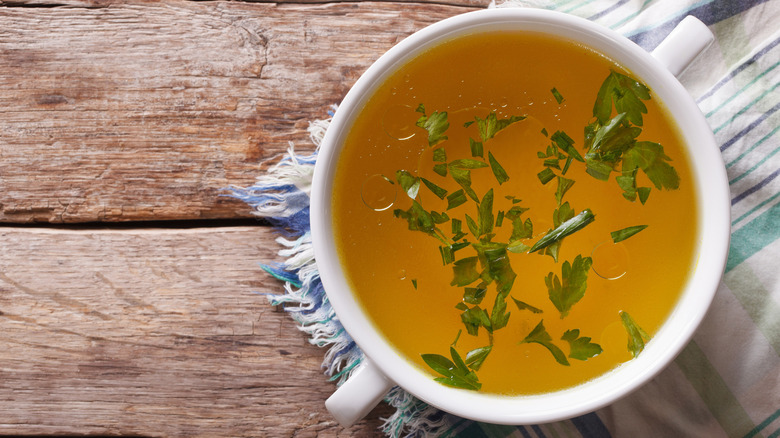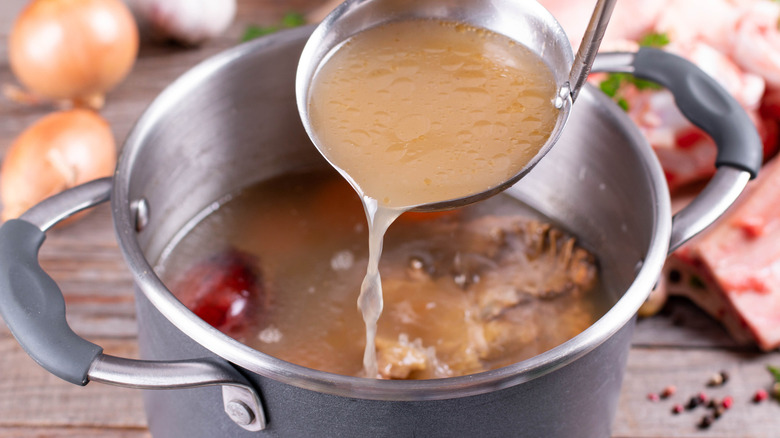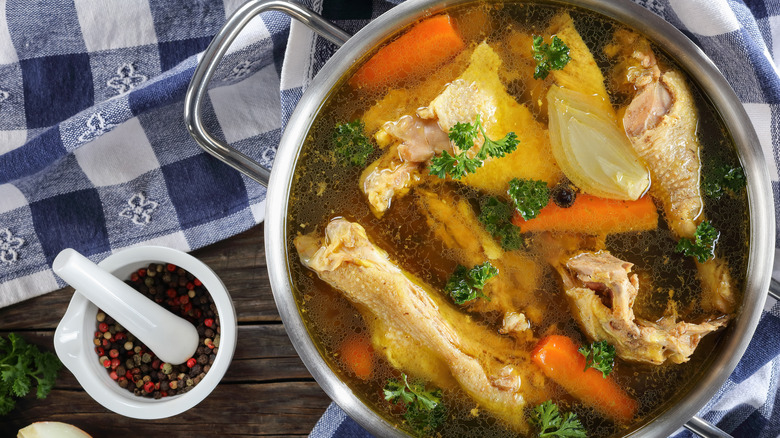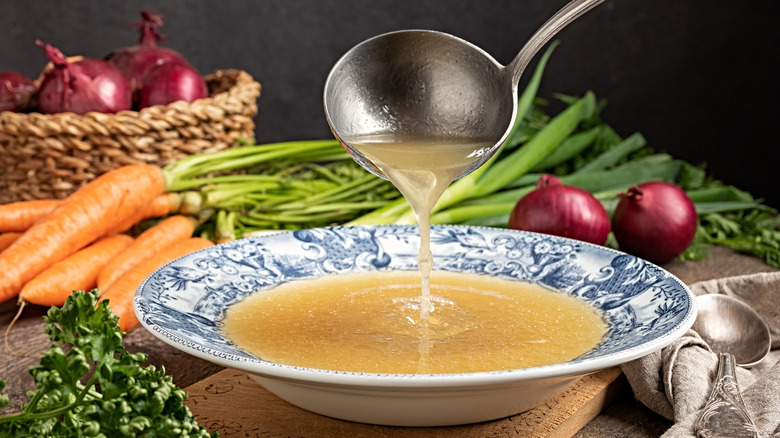Chicken Stock Vs Broth: What's The Difference?
It's important to keep your pantry stocked with staple items in case of emergencies or to just have ingredients on hand that you can make a meal with when you don't feel like going to the grocery store. Although everyone's pantry essentials are different, NYT Cooking suggests stocking yours with oils and vinegars, cans and jars (such as tuna and tomato paste), grains and starches (such as pasta, beans, and rice), dried spices and herbs, nuts and nut butter, preserves and pickles, condiments and sauces, baking supplies (such as flour, baking powder, vanilla extract, and chocolate chips), as well as sweeteners (such as honey and sugar).
Also, you should always have boxed chicken stock in your pantry; the same goes for chicken broth. Both stock and broth are super versatile and can be used for pretty much anything, from the base of soups and stews to cooking risotto and pasta and more. However, while broth and stock seem very similar, there are a few big differences between the two. Here's what you need to know.
Chicken stock is made with chicken bones
Chicken stock is made with chicken bones that have been boiled and simmered in water for at least six to eight hours, if not longer (via Healthline). Letting the chicken stock simmer for this long gives the collagen and marrow from the chicken bones a chance to soften and dissolve into the water, thickening the stock and giving it a gelatinous consistency. Sometimes cartilage is used in addition to bones, and you can also use beef, pork, and fish bones to make respective stocks. Stock is sometimes referred to as bone broth; however, this term is contradictory since the use of bones would automatically make it a stock and not a broth.
Because they aren't as flavorful as broths, stocks are typically used as a base for sauces, gravies, stews, and soups, or for braising meats and vegetables and cooking rice, beans, lentils, quinoa, and other legumes and grains (per Healthline). However, herbs, such as parsley, thyme, and oregano, and vegetables, such as garlic, onion, carrots, and celery, can also be simmered with bones to add more flavor to the stock, if desired. Here's an Instant Pot chicken stock recipe that you can try.
Chicken broth is made with chicken meat
Chicken broth is a lot more flavorful than chicken stock, and it's made with chicken meat that's simmered in water with vegetables, such as celery, onions, peppers, garlic, and carrots, and herbs, such as bay leaves, oregano, cilantro, parsley, and thyme (per Healthline). Because it uses meat and not just bones, chicken broth is simmered for a lot less time than chicken stock, usually for an hour or just until the meat has cooked through. Cooking chicken broth longer will toughen the meat.
The lack of bones in chicken broth gives it a thinner consistency, and any type of meat can be used, as well as just vegetables, for a meatless alternative. According to Healthline, broths are ideal to use in casseroles, stuffing, soups, gravies, and cream sauces, or for sauteing and stir-frying, as well as cooking risotto, legumes, and other grains. This 15-minute homemade egg drop soup recipe is a delicious way to use chicken broth.
Can broth and stock be used interchangeably?
Healthline says that you can swap broth and stock for one another, but some dishes may be better off with one or the other. For example, stock should be used when the ingredients themselves give the dish a hearty flavor profile, and the additional flavor isn't needed, but the extra liquid is, such as with a beef pot roast. On the contrary, broth should be used when the majority of the dish depends on a flavorful liquid, such as in a chicken noodle soup recipe. Also, according to Food Network, broth tends to have more sodium than stock, so either look for low-sodium options with less than 140 milligrams per serving or make your own broth or stock, where you can decide how much salt is added.
Furthermore, 1 cup of chicken stock has about 86 calories, and 1 cup of chicken broth has about 38 calories. Compared to broth, stock contains marrow and collagen, more minerals and vitamins, and has higher protein, fat, and carbohydrate levels (via Healthline). On the other hand, 1 cup of chicken stock has 8.5 grams of carbs and 3 grams of fat. In terms of calories, fat, and carbs, broth is the healthier option, with 3 grams of carbs and 1 gram of fat per cup. Plus, adding vegetables and herbs can help raise the nutritional value of broth — be sure to watch for sodium levels, though.



